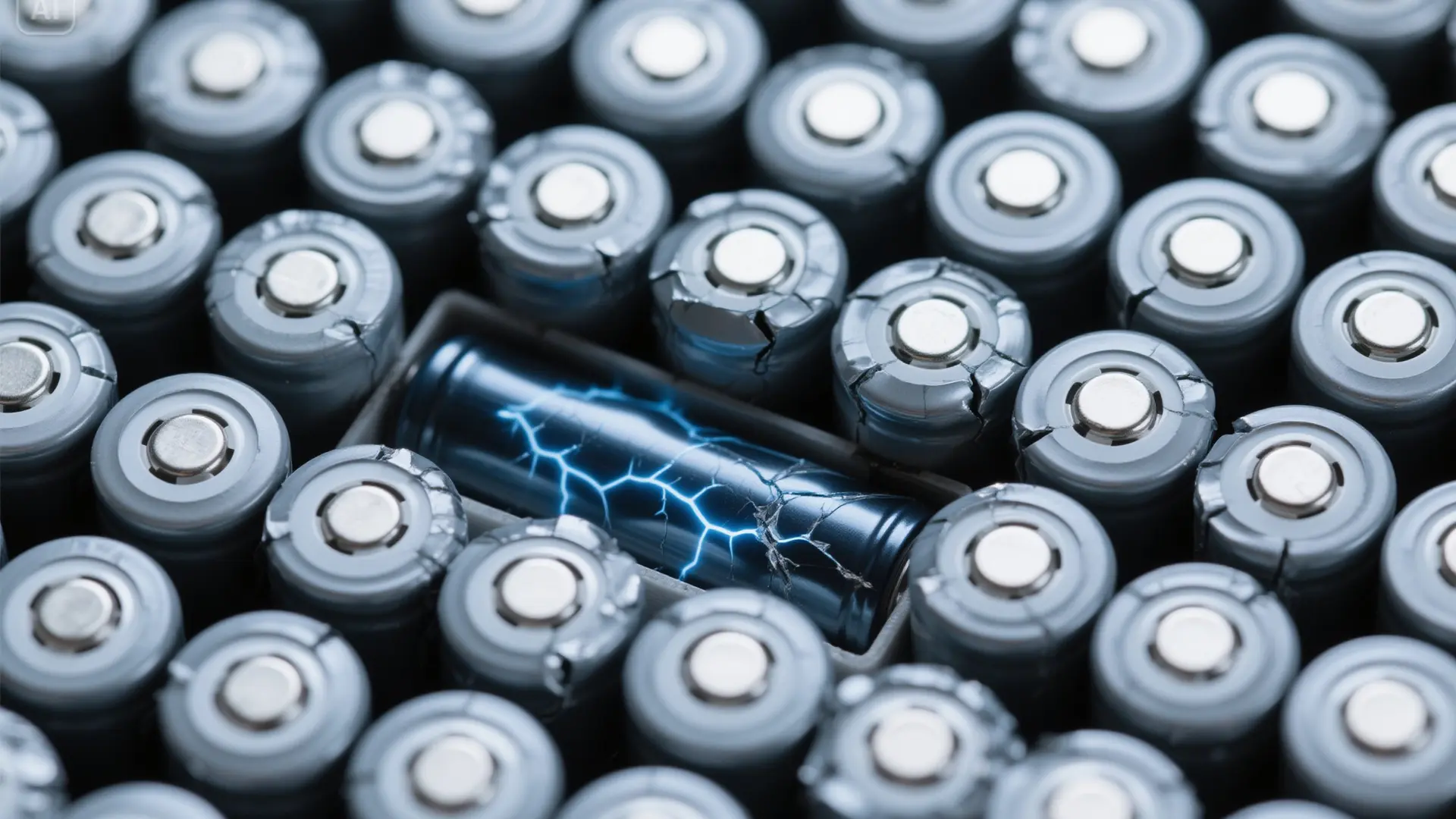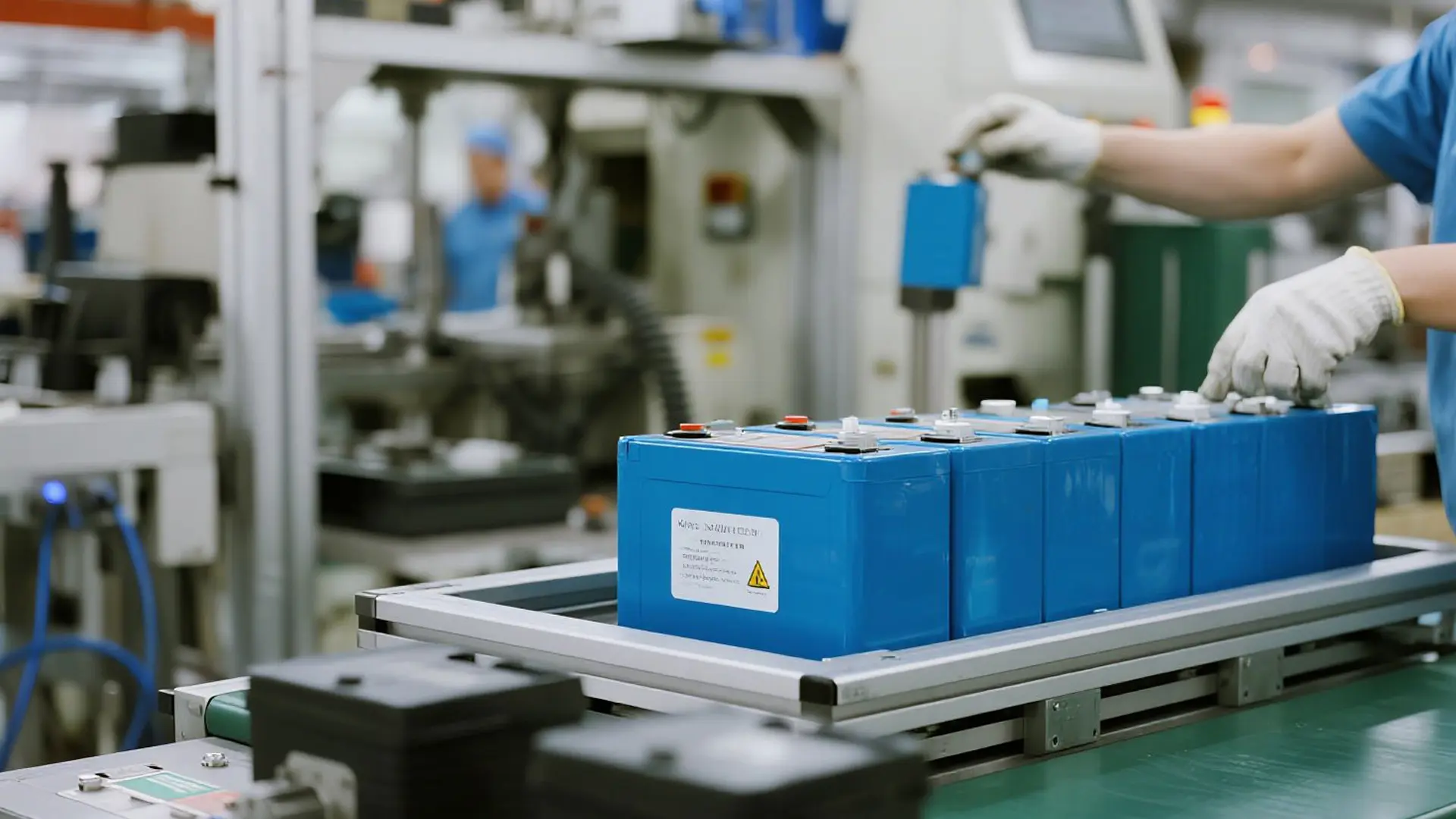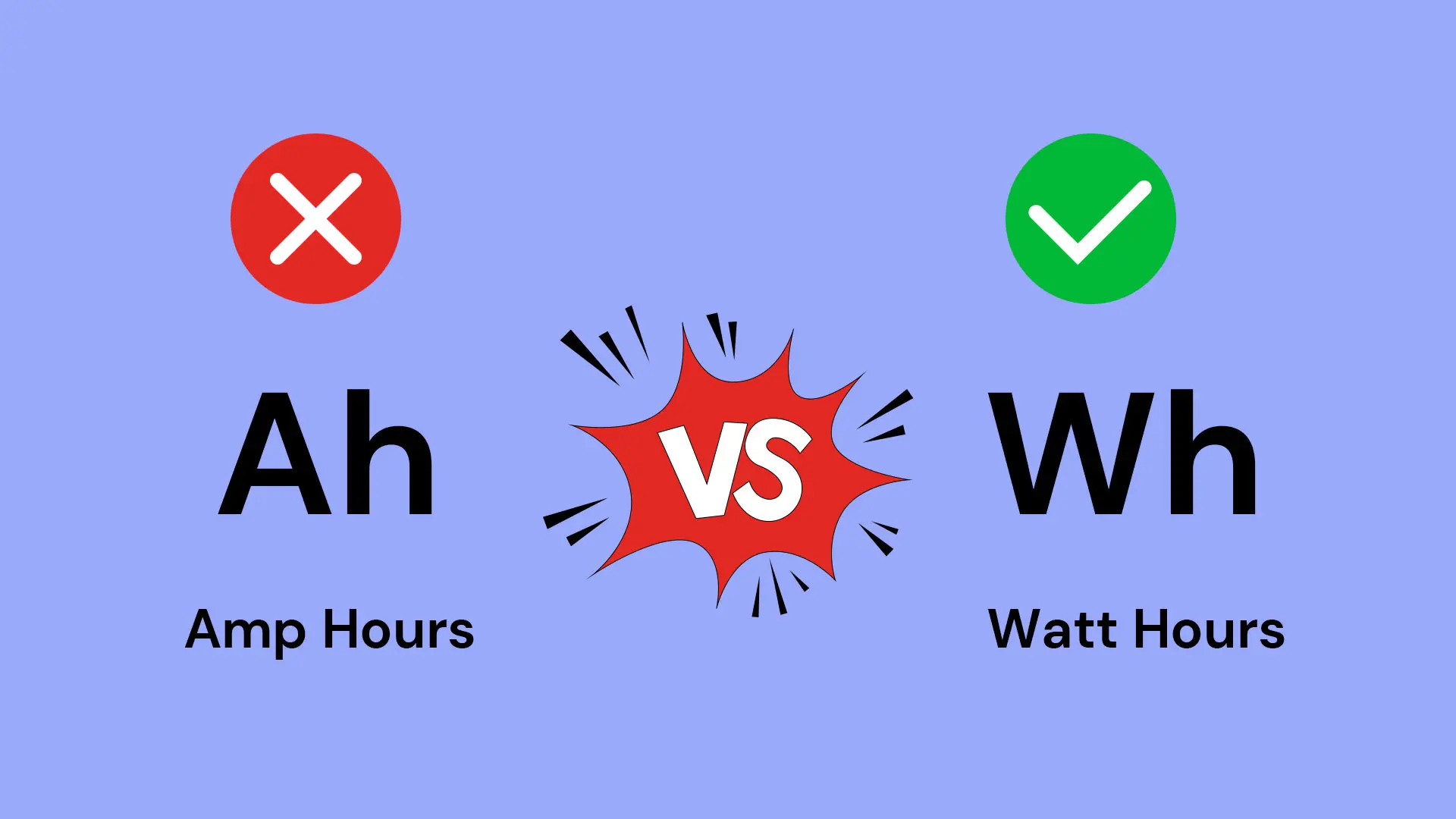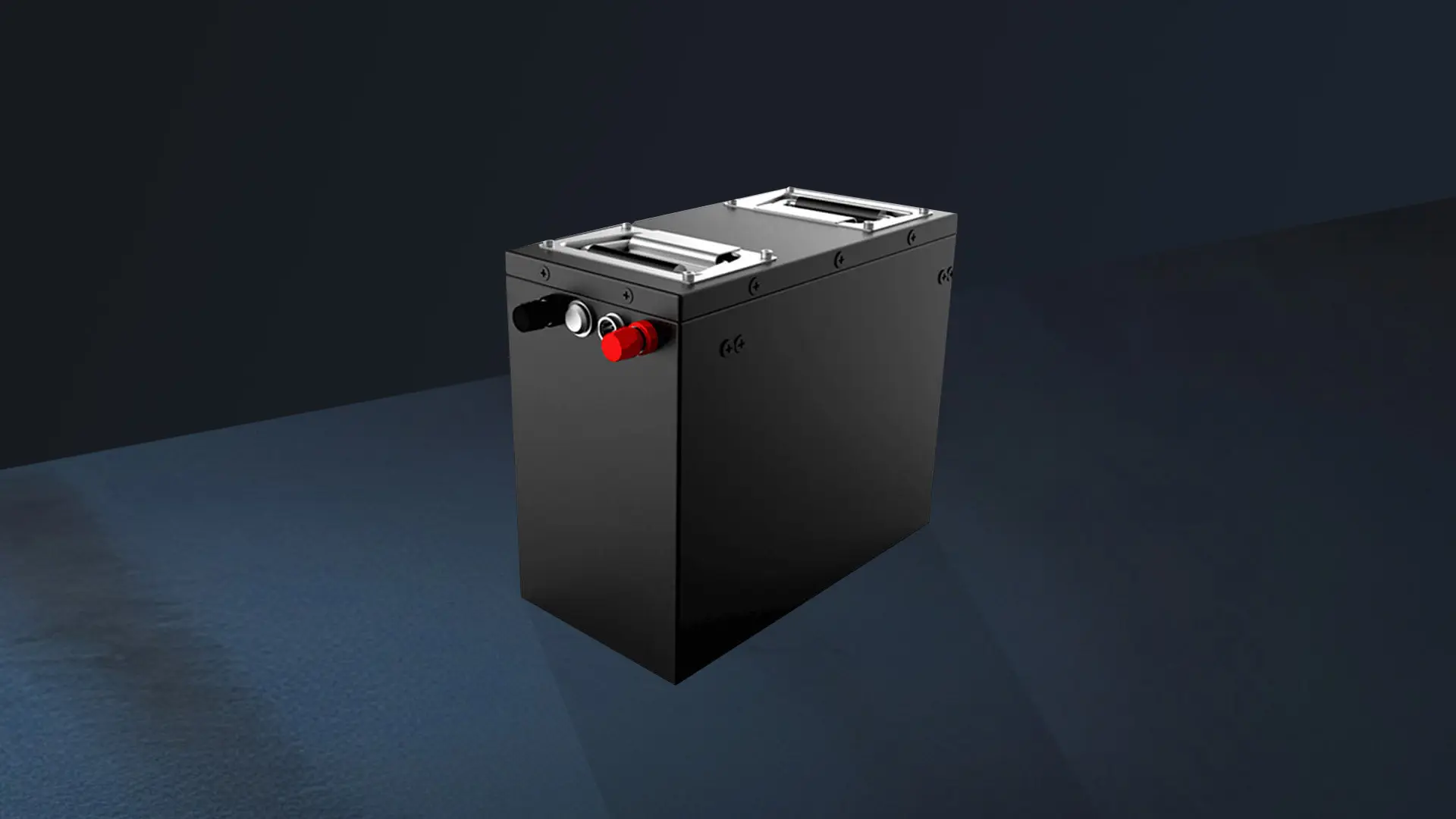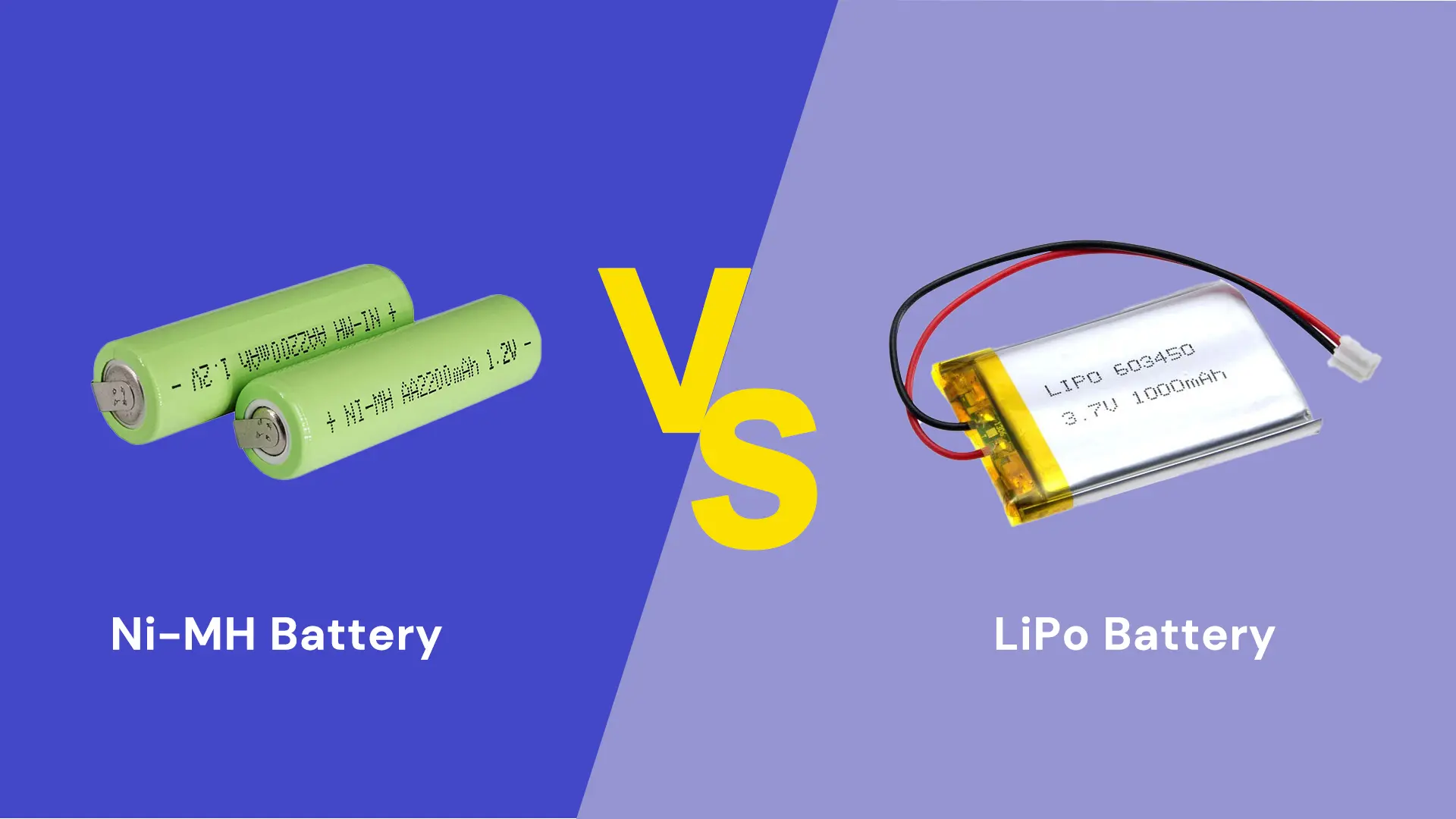A lithium battery leak refers to the electrolyte inside the battery flowing out of the battery shell. If not managed properly, it leads to serious safety risks. Understanding how to identify lithium battery leakage, the cause of leakage, the correct handling procedures, and how to prevent leakage are critical for everyone who uses lithium batteries.
Key Takeaways:
- Overcharging, extreme cold and heat, physical damage, improper welding process, and inferior materials are major causes of lithium battery leaks.
- Material-level protection, structural innovations, a smart monitoring system, sound storage conditions, and regular inspection are conducive to preventing lithium-ion battery leaks.
- Isolating batteries in a sealed container, instant cleanup, and proper disposal and recycling procedures are necessary if a lithium battery is leaking.
Do lithium batteries leak?
Yes, lithium batteries have a leakage risk. However, qualified lithium-ion batteries will not leak easily in normal conditions. Factors like manufacturing defects, improper use, and external damage contribute to lithium-ion battery leaks. For lithium-ion batteries, overcharging, over-discharging, high temperature, and physical puncture cause abnormal internal pressure of the battery, which leads to leakage.
Lithium-ion battery leakage is a dangerous thing. Think highly of it if your lithium battery is leaking; then take proactive action immediately. That’s because lithium batteries release harmful chemicals once a leak occurs, posing harm to humans and the environment. Let’s explore the causes, signs, and what to do, what not to do, and preventative measures for lithium-ion battery leakage.
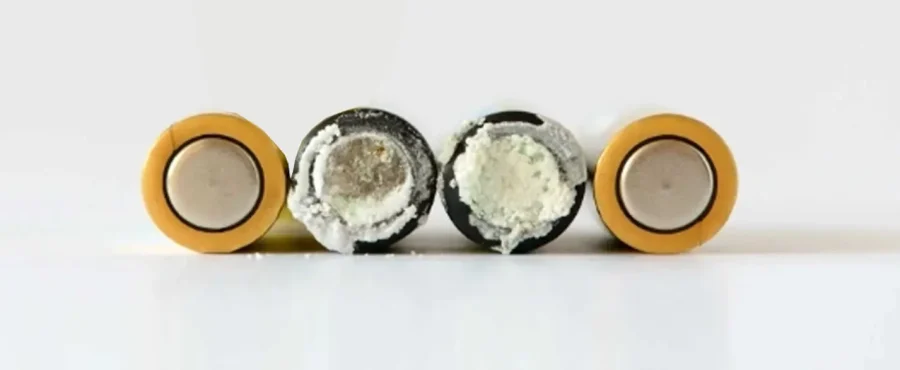
Types of Lithium Batteries Prone to Leakage
Ternary lithium batteries (like NCM/NCA):
These batteries offer high energy density but lower chemical stability. Overcharging, high temperatures, or physical damage can cause electrolyte breakdown, leading to leakage or even thermal runaway.
Cylindrical lithium batteries (such as 18650 models):
The steel casing is strong, but if the sealing process is poor or the battery is crushed, electrolyte may leak from the welded tab area.
Prismatic power batteries:
Commonly used in electric vehicles, their aluminum casing can corrode or lose its seal over time due to internal pressure changes, resulting in leakage.
Currently, LiFePO4 batteries and solid-state batteries stand out in the market for their excellent resistance to leakage.
What Causes Lithium-ion Batteries to Leak?
Numerous factors contribute to lithium battery leaks. Diving into these potential reasons is conducive to preventing batteries.
1. Short circuit and overcharge. They increase the battery’s internal temperature and gas accumulation, triggering electrolyte decomposition and diaphragm damage. These are major reasons for lithium battery leaks.
2. Electrolyte aging. Harmful substances accumulate in the electrolyte with battery aging, reducing stability and increasing gas generation, increasing the battery leakage risk.
3. Exposure to high temperature. Lithium battery accelerates the chemical reactions and generates large amounts of gas in extreme heat conditions, causing negative short circuits and leakage. Choose a professional high-temperature battery for extreme overheating conditions.
4. Physical Damage. Puncture, extrusion, bending, and severe drops deform the battery’s internal laminated or wound structure. These are the enemies of lithium-ion battery leakage.
5. Improper welding process. Excessive welding current and prolonged welding time result in casing deformation and weld cracking, leading to leakage. Inaccurate welding position and loose welding also reduce the battery’s sealing stability and increase leakage risk.
6. Defective materials. An inferior battery separator is prone to being penetrated by lithium dendrites during the charging process, causing a short circuit. What’s more, the broken battery casing material affects sealing. Both of them are key factors that cause battery leakage.
Signs of lithium-ion battery leakage
Discerning the early signs of lithium battery leak is vital to prevent further serious damage. Here are some common hints.
Abnormal Smell
Pungent chemical odor and a burnt smell are obvious indicators of electrolyte leakage. This means that the battery occurs overcharging or thermal runaway, producing toxic gases, such as fluoride, ammonia.
Physical Deformation: Swelling& Shell Crack
- Physical distortion. Shell cracking, swelling, and smoke indicate that the lithium battery is leaking.
- Abnormal casing change. The battery shell usually has cracks and signs of damage. Corrosive electrolyte and the intense chemical reaction lead to spots, fading, which are the obvious leakage signs.
Chemical Leaks
- Electrolyte leakage. If you feel a sticky substance or liquid on the surface of the battery, it may be an electrolyte leak.
- Corrosion marks. Electrolyte leakage takes chemical reaction with the battery casing or connection parts, causing corrosion, spotting, or oxidation on the positive and negative terminals, ports, and battery casing surface.
Degraded Device Performance
- Sudden device shutdown, rapid power outage, and a sharp drop in battery capacity are common indicators of lithium-ion battery leakage.
- The battery temperature heats up when charging or using. It occurs a short circuit or leakage inside the battery occurs, causing the lithium battery to undergo thermal runaway and the battery temperature to be uncontrollable.
Why is lithium battery leak dangerous?
Lithium-ion battery leakage poses a threat to human health, deteriorates the device’s performance, and increases fire risks. Understanding these dangers helps with timely treatment and prevention, extending the life of the device.
Hazards to Health
When a battery leaks, the chemicals inside it leak out. These chemicals are often corrosive and toxic. The electrolyte is lithium LiPF6 liquid. If the electrolyte comes into contact with water or humid air, it will explode. Direct contact with these substances causes serious consequences such as skin burns, eye irritation, and even poisoning.
Damage to Device Performance
The electrolyte inside the battery corrodes the device’s circuit boards if a lithium battery leaks, causing performance degradation or malfunction. Furthermore, leakage results in a short circuit, exacerbating damage.
Safety Risks
If a lithium battery leak is improperly handled or not discovered in time, it leads to battery thermal runaways and causes safety hazards such as fire or explosion. Leaking lithium-ion batteries are prone to performance degradation, environmental pollution, and corrosion in high temperatures and high humidity.
How does lithium battery leakage harm device manufacturers?
For equipment manufacturers, a leaking battery is far more than a simple component failure—it poses a serious systemic risk. A large-scale leakage incident can lead to massive recall and after-sales costs, placing severe operational and financial strain on the company.
Moreover, if consumers begin to associate a brand with “unsafe batteries,” the long-term damage to its reputation can be profound and difficult to repair. Such safety issues may also constitute non-compliance with critical international standards such as UL, CE, UN38.3, and IEC62133, exposing the company to significant regulatory and legal risks.
Ultimately, battery safety is directly tied to a business’s financial health, brand survival, and legal compliance.
What to do with a leaking lithium battery?
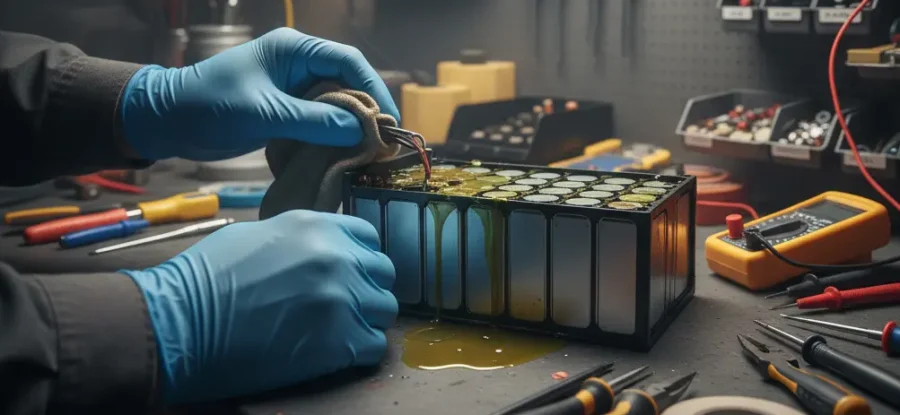
Stay calm when your lithium battery leaks. It’s vital to handle it safely to minimize harm. When handling a leaking lithium-ion battery, please first stop using the battery, take protective measures, clean up the battery leak, and finally recycle this leaking battery. The following step-by-step methods help you cope with this situation.
Prompt Response Measures
- Immediately turn off the device and stop charging the battery. Determine the battery leakage situation and stop continuous use battery. No attempt to use the battery to ensure safety and prevent further battery damage, fire risk, or health hazards.
- Take protective measures. Immediately put on rubber gloves and goggles for safety. Rubber gloves prevent the leaked liquid from corroding the skin, and goggles protect the eyes and avoid injury caused by splashing liquid.
- Isolating the leaking battery ensures a safe distance. After removing the leaking battery, place it in an open and well-ventilated area. Keep leaking batteries at least 1 meter away from flammable objects, electronic products, or corrosive objects.
Cleanup of Lithium Battery Leaks
- Blotting the leak. Use an absorbent paper towel or rag to blot the leaking liquid. Be gentle and avoid spreading the liquid. Then, place the used paper towel in a sealed bag.
- Lithium battery leaks are cleaned with a solution of baking soda and water. Dip a cotton swab or soft cloth to wipe the leaking area, removing the remaining corrosive substances.
- Wrapping the battery. Cover this leaking area with tape to seal it to prevent further leakage or evaporation. Place the battery in a sealed plastic bag, and squeeze out the air.
Professional Recycling and Disposal
Find a designated battery recycling center. Do not simply throw a leaking lithium battery in the trash. Contact a professional team. If you are unsure how to handle the battery or if the leak is severe, it is best to request expert battery recycling or disposal company help. If you are interested in the entire lithium-ion battery recycling process, check out this article.
What not to do when a lithium-ion battery is leaking?
The following are the precautions for handling leaked lithium batteries. Learn the following tips to ensure your life safety.
1. Prohibit charging or discharging the battery. A leaking lithium battery is damaged, and continued use causes overheating, explosion.
2. Avoid direct contact with leaked electrolyte. The leaking electrolyte is Lithium LiPF6, containing corrosive HF acid when in contact with water. This leads to serious consequences such as skin burns and respiratory harm.
3. Do not rinse or soak the battery in water. The reaction between water and electrolyte increases the risk of damage, triggering a chemical reaction that produces toxic gases and leading to an internal short circuit or explosion. If the battery gets into the water, disconnect the power and store it upright to prevent moisture from entering the battery.
4. Do not use metal tools or hard objects to scratch the battery casing or internal separator, causing a short circuit and increasing the risk of explosion. Use a dedicated anti-static brush or soft cloth when cleaning.
5. Stay away from high temperatures and flames. Leaked electrolyte ignites rapidly in extreme heat conditions, causing a fire or explosion.
6. Do not disassemble and modify the battery yourself. It exposes internal chemicals, posing a dangerous risk. If the battery is damaged, contact a qualified service center.
How to prevent lithium battery leak?
Proper methods are supportive of guarding against battery leaking, thereby extending battery service life and enhancing safety. The following steps are key preventive measures.
We have developed a comprehensive anti-leakage solution for customized lifepo4 battery packs by integrating advanced materials, innovative structural design, and intelligent monitoring systems.
1. Core Technical Architecture
1.1 Material-Level Protection
- LiFePO4 Cell Chemistry: Electrolyte decomposition temperature ≥200°C, which is 60% higher than standard NCM/NCA lithium cells.
1.2 Structural Innovations
- Laser Welding + Silicone Gasket: Achieves IP68-grade sealing and protection.
- Inside the battery pack, flow channels and absorbent materials such as microfiber cotton are integrated to quickly capture and lock in electrolyte in the event of an accidental leak. Capture and neutralize more than 99.7% of leaked electrolyte.
1.3 Intelligent Monitoring System
- Integrated Pressure and VOC Sensors (1 ppb accuracy): Continuously monitor electrolyte vapor concentration and provide early warning of potential seal failure.
- Dynamic Charge/Discharge Control: Adjusts charging and discharging strategies in real time to prevent overcharge or over-discharge, which can lead to electrolyte decomposition and gas generation.
1.4 Extreme Environment Adaptation
- Automotive-Grade Validation: Battery packs are tested under temperature cycles from -40°C to +85°C.
- PTC Heating Film: Built-in heating layer prevents electrolyte solidification and expansion under low-temperature conditions.
2. Best Practices for Preventing Battery Leakage
Beyond advanced design and testing, proper usage and handling play a critical role in keeping batteries safe and leak-free. Here are key practices for B2B users and OEM/ODM partners:
2.1 Storage Conditions
Always store batteries in a cool, dry environment (15°C–25°C). Avoid high heat or humidity, which can accelerate electrolyte breakdown.
2.2 Avoid Overcharging
Overcharging increases internal gas generation and swelling. Use smart chargers or timers to ensure safe charging cycles.
2.3 Regular Inspections
Inspect batteries monthly for any swelling, cracks, or corrosion on the casing and terminals. Replace any defective units immediately to avoid leakage risks.
2.4 Handling and Transportation
Keep batteries away from metal objects that could cause short circuits. Avoid punctures, drops, or heavy impacts, as physical damage is a leading cause of leakage.
2.5 Battery Selection
Only use manufacturer-approved, compatible cell models in your devices. Non-certified batteries may not fit properly, leading to leakage or performance failure.
FAQs about Lithium Battery Leak
1. How to clean lithium battery leaks?
Prioritize safety when cleaning a leaking lithium-ion battery. At first, put on gloves and goggles to avoid touching this leaking liquid. Second, using a clean cloth to absorb the electrolyte prevents further spread, which is suitable for small spills. Third, use a weak acidic cleaner to neutralize the acid in the leaked electrolyte. Use vinegar to clean if the electrolyte has spilled over a large area. For a metal surface, treat leaking material with alkaline detergent and a wire brush. Then, do not throw away leaking batteries. It is better to give them to a professional battery recycling agency.
2. What does a lithium battery leak smell like?
The leaking lithium-ion battery produces a sharp and unpleasant smell. It originates from leaking electrolyte that contains organic solvents and lithium salts. The odor is irritating and harmful to humans.
3. What does a lithium battery leak look like?
The battery casing is bulging. What’s more, the lithium-ion battery leakage residue on the battery surface is transparent and light yellow. Leaking lithium-ion battery showing signs of corrosion. Additionally, the device’s battery capacity is suddenly reduced, and charging is difficult.
4. How to repair a leaking lithium battery?
It is not recommended to repair leaking lithium-ion batteries. That’s because these batteries contain flammable and explosive chemicals. It is sensible to handle it immediately and avoid direct contact with the leak. Collecting leaked electrolyte and battery fragments in a sealed container prevents the spread of the leak.
5. Can I still use a lithium battery if it leaks?
Not recommended to continue using a leaking lithium-ion battery. Chemical reactions and leakage within the battery damage its structure and function. It is advisable to choose a new one from reputable battery manufacturers. Avoid overcharging and protect the battery from exposure to high temperatures.
6. How can I store used batteries without them leaking?
Please observe the following points when storing old batteries to prevent lithium-ion battery leakage. First, use insulating tape to wrap the battery terminals to prevent short circuits or contact with metal objects. Second, store it in a corrosion-resistant, leak-proof sealed container. Third, storing different batteries separately to avoid chemical reactions. Fourth, storing batteries in a dry and cool place, away from high temperatures, humidity, and fire. Then, avoid batteries being subjected to external impact to prevent the casing from leaking.
Conclusion
Lithium battery leakage poses not only technical failures but also severe supply chain and brand risks. At CMB, we provide application-tailored, certified battery solutions with robust leakage prevention design and rigorous testing, helping you ensure product safety, reduce recalls, and access global markets with confidence.

